What are flowering shrubs names. Shrubs for hedges: photos and names
Shrubs are another large group of woody flowering plants. Unlike trees, they are characterized by the presence in the adult state of not one main trunk, but several, growing side by side and reaching different thickness and heights. These stems originate at the very surface of the soil from the dormant buds of the main shoot, which is developed from the seed. They grow rapidly, often overtaking the mother shoot and gradually replacing each other due to the death of stems in the center of the bush and the appearance of new ones on the sides. The life expectancy of shrubs as a whole can be several hundred years, but individually, each of the shoots lives on average from 10 to 40 years, and their height ranges from 0.8 to 6 m.
Shrubs are widespread throughout the planet from equatorial regions to cold zones. Most often they are wild (hazel), which are located both on the outskirts of forests (forest-tundra, shrub steppe) and in forests, forming undergrowth. In landscape decoration suburban area Ornamental shrubs, with their wonderful foliage and charming flowers, are also an integral part of the garden. Today, many species of these plants are known, which perform different functions. The main ones are fruit, ornamental deciduous and ornamental flowering shrubs. Plants of the first type are capable of producing fruits rich in vitamins, most of which a person eats. These include gooseberries, currants, raspberries, barberries, blackberries, etc.
Often small bushes bloom very attractively and beautifully (jasmine, lilac, hydrangea, hibiscus, spirea, etc.). There are varieties of ornamental shrubs that bloom in spring or summer. In addition, their flowers come in completely different colors, shapes and sizes.
Those garden shrubs, which bloom inconspicuous flowers (boxwood, ivy), are also highly valued due to their very beautiful leaves of bright green color and unusual shape. They are mainly used to form hedges, as well as in various plant compositions that complement landscape design. When choosing such types, the main role is played by the color and texture of the sheet.
All shrubs react differently to frost and sunlight. In this regard, they are divided as follows:
- very frost-resistant plants - red elderberry, Siberian hawthorn, Siberian derain, tree caragana, etc.;
- frost-resistant - this is common viburnum, common hawthorn, Tatar honeysuckle, wrinkled rose, western thuja, etc .;
- moderately frost-resistant - spirea, common privet, mock orange, wild rose, etc .;
- light-loving crops are lilacs, wild roses, spirea, mountain ash, rowan-leaved, etc.;
- semi-shade-tolerant - red elderberry, Tatar honeysuckle, hawthorn, viburnum spirea, panicle hydrangea, etc .;
- shade-tolerant - hazel, red derain, common privet, warty euonymus, etc.
Planting seedlings of ornamental shrubs is mainly carried out in autumn. For this purpose, a month after the leaves fall, pits are dug, drainage is poured into them and seedlings with an open root system or with earthen clods are placed. However, heat-loving varieties of plants take root better in the spring, and they are planted before the buds begin to bloom on the shoots.
Ornamental shrubs are one of the most effective and efficient tools that every landscape designer uses at the present stage. At the cottage or garden plot they quite often play the role of a beautiful living fence, which has an attractive emerald green hue. In addition, small shrubs for the garden are used as a kind of smooth transition from large to grass cover. The most important function of these plants is to create a harmonious design of the backyard area, if necessary, softening certain nuances of design ideas.
Probably, almost every summer cottage or household plot has shrubs on its territory. Inexperienced or lazy summer residents get a lot of problems from them, but for caring summer residents and gardeners, beautifully flowering shrubs become real masterpieces landscape design. The difference between a wild rose, which no one takes care of, or a barberry, which has scattered branches on all sides, and a boxwood, carefully trimmed, is immediately visible - it is more than palpable. For recent years such a design trend as topiary art has become especially popular. In it, plants such as flowering shrubs for a garden of one kind or another have become a truly indispensable element.
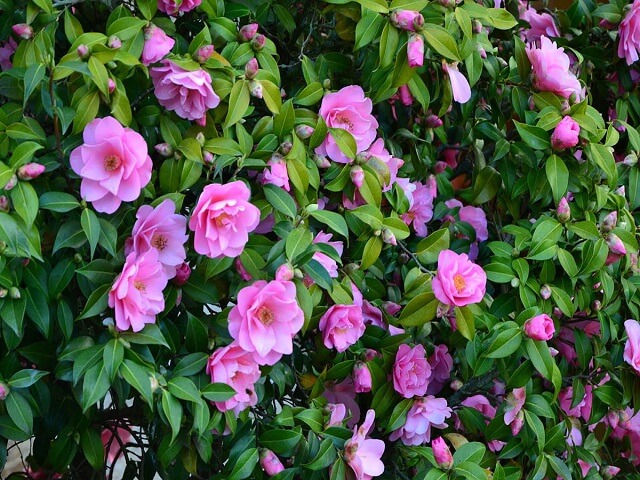
Under the condition of competent, regular and thorough care for them, the owner of the estate or cottage receives a lot of advantages! Such shrubs for giving are not only a bright decoration of the territory, a slender hedge, but also a natural sculpture of stunning harmony. As with every plant, it is typical for a shrub to please the person caring for it with abundant flowering, thanks to the care and care, because most of their species are absolutely unpretentious.
Types and nuances of choice
Flowering bushes look great on any size plot, cottage, garden, regardless of the style and direction in which the design of the territory is decorated. Mini-trees of juicy green color, which slenderly stand in the form of a wall along the perimeter of the site, alleys, or shrubs covering a bright dome of inflorescences, can perfectly fit into all the styles of designing a backyard or summer cottage that exist at the present stage.
Shrubs are classified based on several principles. For example, according to the degree of frost resistance that the plant has. In the process of choosing and acquiring seedlings for your site, you should definitely pay attention to this characteristic.
Hard frosts are not terrible for:
- Siberian hawthorn;
- cedar elfin;
- tree caragana;
- hawthorn;
- wrinkled roses;
- viburnum.
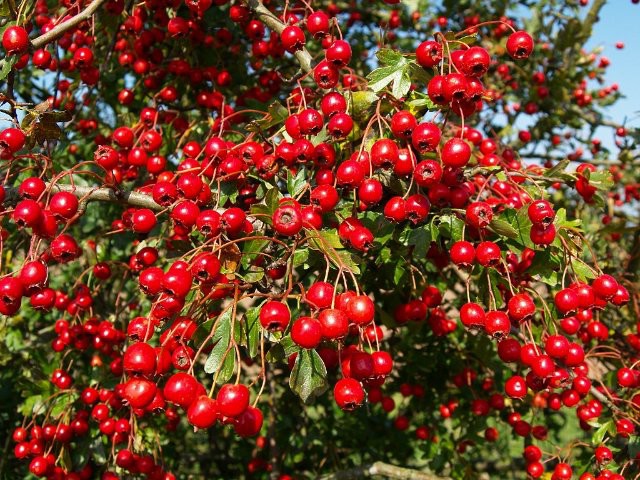
The above plants are characterized by the fact that they are able to easily endure the conditions of the winter season, so they can plant the northern part of the site, and for such shrubs as spirea, wild rose and mock orange, heat is needed - in the process of caring for them, you should definitely take care and resolve the issue of warming them before cold season.
Another sign of classification is the requirements for lighting. For lilac and fieldfare, such places in the garden are best suited, in which throughout the year it always receives a large number of sunlight.
In shaded areas, it is best to plant the following types of bushes:
- warty euonymus;
- hazel;
- derain red;
- common privet.
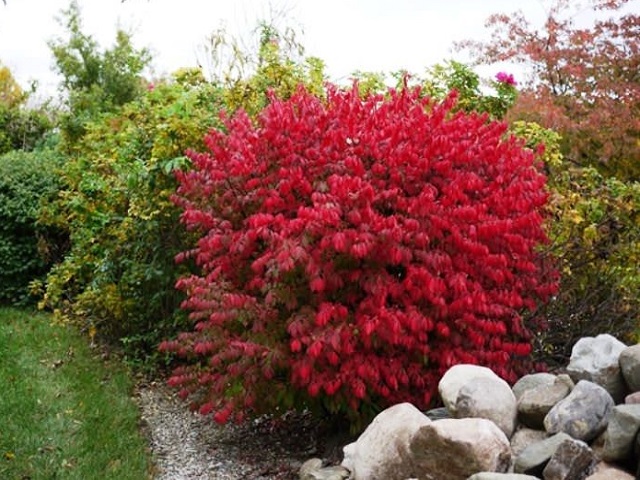
Experts advise gardeners to pay attention that the choice of seedlings of plants such as perennial bushes for landscaping the territory, it is necessary to carry out, necessarily taking into account the type of soil. Japanese quince needs warmth, while it is considered generally unpretentious to the ground. The decoration of such a shrub is small inflorescences and leaves, as well as fruits. Accordingly, such rather modest bushes will bring joy in the spring season with flowering, in the summer months - with juicy greenery, and in the fall - with a generous scattering of decorative berries. In order for dogwood to grow well, it should be planted on soil with high humidity. The inflorescences of this shrub are famous for their very pleasant fragrance, and besides this, the shoots, which have an unusual color, give a rather exotic touch to a simple bush.
The color of the leaves varies, as it depends on the variety: from rich green, with a light border, and ending with dark bronze hues. The forsythia shrub begins to bloom in early spring, that is, at a time when many trees have not woken up from hibernation. Such bushes look like from a fairy tale - they are covered with rich yellow inflorescences!
However, this shrub has a lot of requirements - the success of its cultivation requires fertile soil, as well as moderate watering. For sites that are located in the southern regions and are characterized by sandy soil, the ideal inhabitant is tamarisk - this shrub blooms very beautifully! In general, it is not enough just to know the names of shrubs - you need to carefully study the characteristics and requirements for the process of growing the plant variety that you plan to plant on your site.

ornamental shrubs
According to such a criterion as decorative value, it can be conditionally divided into two groups: the first is deciduous, the second is flowering. Which species to give preference directly depends on the effect that you want to get on your personal plot by growing such shrubs.
Before proceeding to the direct process of creating with the help of shrubs landscape composition, you should familiarize yourself with everything related to the invoice and colors leaves/needles. No need to be afraid to use evergreens, as well as ornamental bushes - do not worry that the composition of them will look boring. Such beauty is in no way inferior to their flowering counterparts.
I wonder if there is such a person in the world who does not like the tart aroma of juniper? Such a coniferous plant is widely used in topiary art, and besides this, also in the process of planning and creating park and country alleys. Evergreens such as mahonia look great in the garden - its foliage has a dark shade and multi-colored panicles. Boxwood will perfectly fit into any composition, which seems to be specially created by nature for any curly haircut.
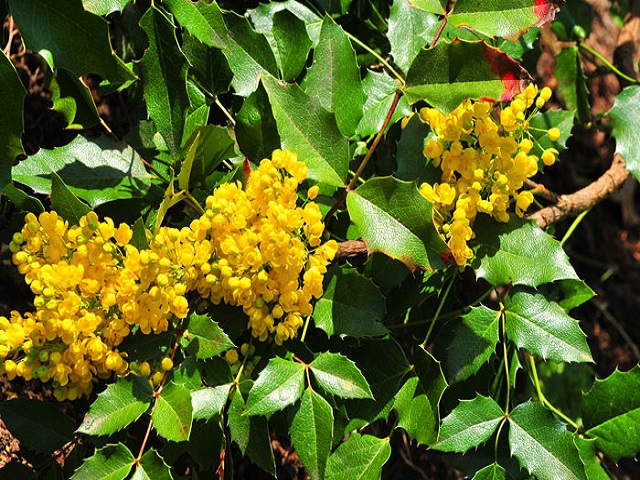
Some shrubs provide the opportunity to observe the change in their color. For example, the leaves of the vesicles change their color: the Aurea bush will throw out reddish leaves from the bud, by the beginning of the summer period they will become almost orange, then fade a little, and during the autumn months they seem to explode with a bright golden color scheme. Moreover, if the vesicle grows in the shade, then its color is always green. Barberries are also characterized by a wide range of colors.
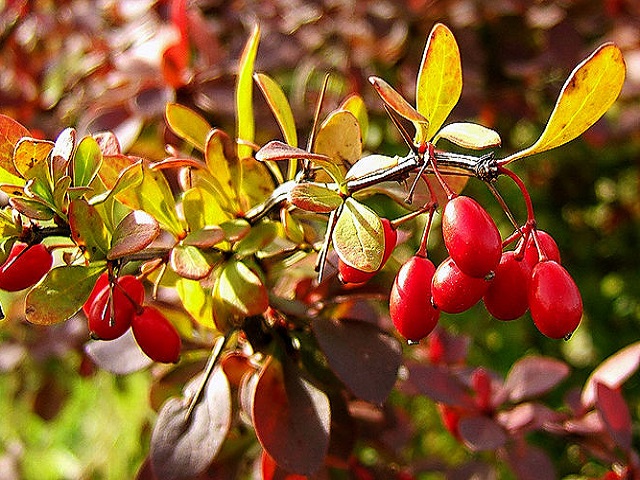
Depending on the type of crown of plants, they are purple or golden, emerald or crimson. They look as elegant as possible near low fences that separate the perimeter of the garden, vegetable garden, and cottages. Look amazing and fabulous flowering bushes. They delight not only people with their riot of colors, but also bees, as they provide a huge range for work. With the advent of spring, lupus and forsythia are the first to bloom, after which lush hats appear on viburnum bushes, and miniature bouquets bloom on white turf. Then the aromas of jasmine spread, lilac bushes come to life with curly clusters. Brooms, rhododendrons, spirea and cinquefoil will add beauty to the picture of the spring summer cottage.
Blooming shade shrubs
You can also decorate the territory of your site with the help of shade-loving green spaces blooming with bright inflorescences. Such plants suitable for planting in a shady corner include:
- rhododendrons, which are beautiful evergreen shrubs that have leathery leaves and incredible bright flowers. These plants are ideal for landscaping an empty shady area;
- garden jasmines look very attractive, thanks to large snow-white inflorescences and a delicate, pleasant aroma. Such plants have a lot of positive characteristics that make their care minimal and simple - garden jasmine bushes love shade, are drought and frost resistant and undemanding to the composition of the soil.
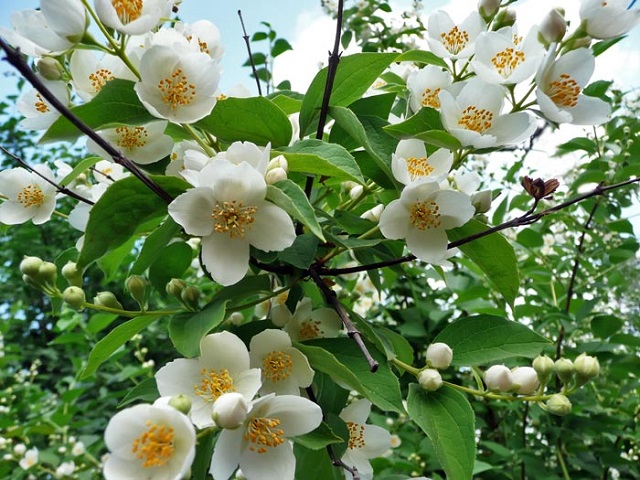
Berries growing in the shade
Every prudent owner wants as many plants as possible to grow on his territory, not only pleasing to the eye, but also bringing some other benefit - for example, berries.
These shrubs are:
- common barberry bushes - unusual plantings with interesting foliage that can change its color, and fruit-bearing berries, which are widely used in oriental cuisine;
- gooseberry, which is a shrub that is absolutely unpretentious to environmental conditions, including not demanding in terms of watering. Its berries are eaten not only fresh, but also provide an opportunity to enjoy delicious amber jam from them.
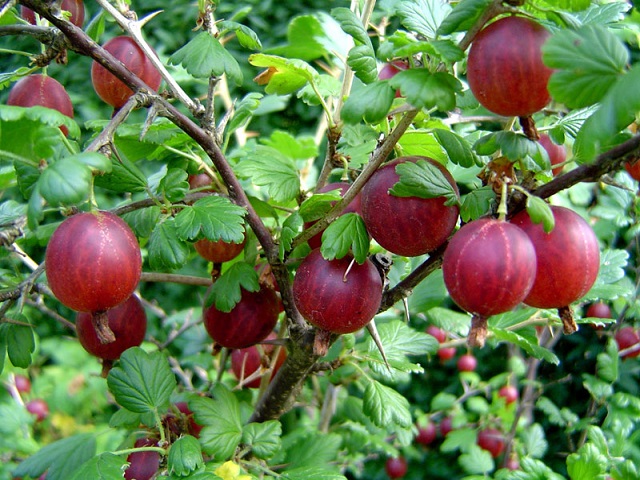
Features of planting bushes
Absolutely all types ornamental plants, including shrubs, must be planted and transplanted in the autumn. The main thing is to make sure that before the arrival of cold weather, the shrubs have enough time to take root.
Planting bushes begins with the stage of choosing a place - in order to do this correctly, it is necessary to take into account the characteristic features of a particular species, which were mentioned earlier.
After the issue with the place is resolved, you can begin to remove, and after that - to remove the top layer of the earth (this is extremely important when landing on lawns).
Then you need to dig a hole, the size of which will be much larger than the width of the root system of the shrub. You should try on the seedling to the pit and enlarge it until the longest root fits freely in it. The surface of the bottom and walls of the pit must be carefully loosened with a fork, which will provide an opportunity to saturate the soil with oxygen. Gardening experts recommend adding compost/peat and a slow-acting fertilizer during the planting process.
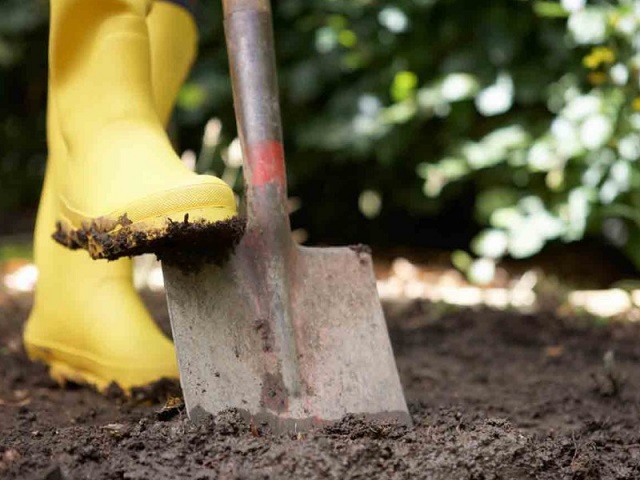
In the very center of the dug hole, you need to hammer a peg - it is necessary for tying the plant. If the garter of the seedling is carried out after planting, it is possible to significantly damage the shrub, which has not yet grown strong.
Then you should put the plant next to the peg, straighten its root system and carefully cover it with soil. Feet should carefully compact the ground. Around the diameter of the pit, it is necessary to make a roller out of the soil - it will become an obstacle to the spreading of water, and it will go directly under the root system of the bush. At the end, you need to water the planted shrub abundantly.
It remains only to tie the seedling to the peg - this will allow the root to be in one place, and it will not be able to move anywhere, and in the future the shrub will be able to stretch strictly vertically. It is necessary to apply a bandage, which is made of any soft materials, at a height of about 30 centimeters from the soil surface.
shrub care
A fairly common idea that growing green spaces such as garden shrubs implies careful maintenance is wrong! It is necessary to get rid of the stereotype artificially created by cinema: in the garden near a luxurious mansion, the gardener is forced to spend whole days, working from morning to evening, cutting shoots and shaping the crown of lush shrubs.
In reality, the bushes require only periodic hilling and competent watering. Naturally, in addition to this, it is still necessary to trim excess branches from time to time in order to give the shrubs a well-groomed shape, as well as cut off old shoots. Frost-resistant species of these plants do not need any specific preparation for the conditions of the cold season. For roses, hydrangeas and rhododendrons, cover with reeds and spruce branches is enough.
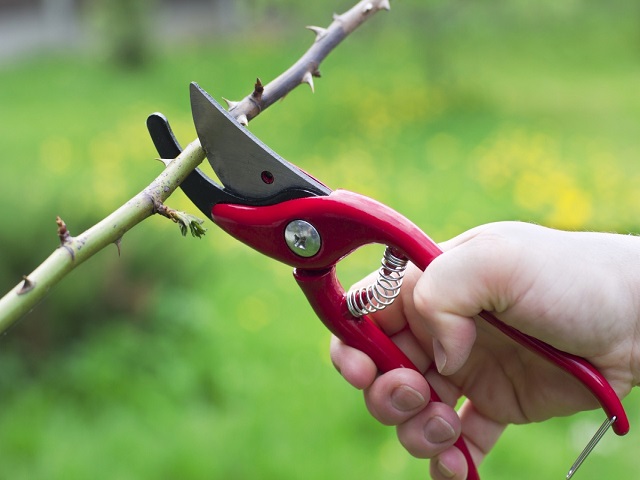
To get a good result, it’s not enough just to understand the names and features of such plantings as shrubs that bloom throughout the summer season and are resistant to cold and frost in the winter season. It is imperative to know and correctly use the main rules for caring for these plants in the process of growing bushes. After all, improper care can destroy even not very whimsical plants.
First of all, it is necessary to observe the trimming periods. Even at the stage of buying a seedling, you should think about this - you just need to ask the seller when to start pruning and how exactly to do it. Neglecting such things threatens that they will quickly develop into awkward sloppy trees that will not look good and spoil appearance plot in the country or in a private house.
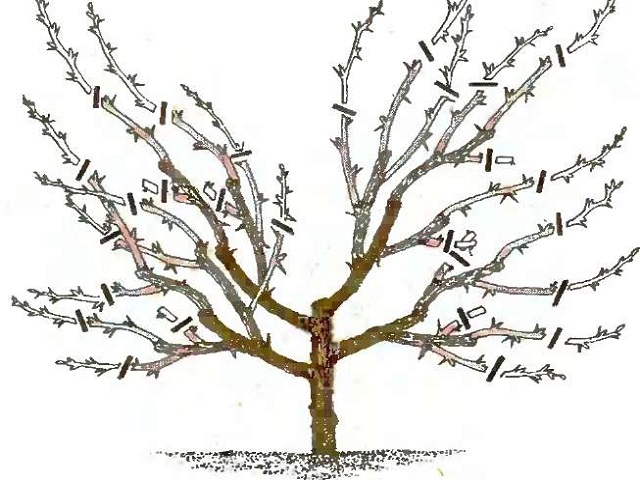
There is a special charm in the days when winter is just coming into its own. While the ground has not yet been covered with a thick snow blanket, the mysterious streaks of fog floating above the evergreen hedges sparkling from hoarfrost enchant and attract the eye. Openwork ice crystals accentuate the jagged outlines of dark green holly leaves and give a silvery sheen to small boxwood leaves and purple barberry leaves. And when the sun finally emerges from behind a veil of clouds, the bright foliage of the hedge of beech, field maple or hornbeam appears in all its glory.
The pond, framed by vervain bushes and boxwood, covered with frost, looks especially mysterious and poetic in the morning.
The value of hedges not only in protection from prying eyes - the color and clear forms make them important element garden decoration. Take at least a garden. In a low "frame" it looks much neater even in winter. And the garden bench seems especially cozy if it is protected from behind by a hedge. At the same time, it is not at all necessary that it be high - it is enough if the fence protrudes slightly from behind the back.
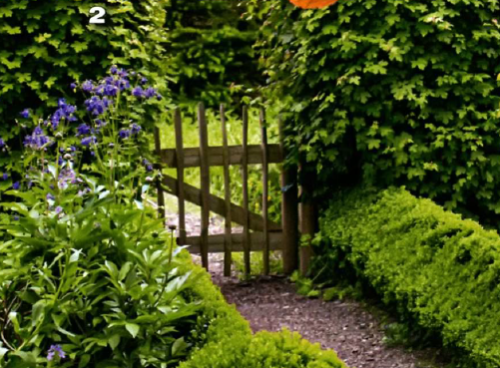
good mix : the border for the flower garden is boxwood, formed in the form of a roof, and a field maple hedge protects the garden from prying eyes.
Hedges behind flower beds from herbaceous perennials on the border of the site, on the contrary, should reach a height of about 1.8 m, so that not too aesthetic objects, say, a compost heap in a neighbor's garden, do not fall into the field of view. If the ridges, for example, along the wall of the house are long, then low hedges can be used as dividing walls. Then they will create structure in plantings, even when summer-flowering plants are no longer pleasing to the eye.
In addition, a flower garden divided into several sectors is easier to fill. Suitable separators are deciduous species of barberry or winter-green privet. It is especially beautiful when late-flowering decorative cereals or asters look out from behind a low hedge. And if there is enough space in your garden, you can decorate the paths with beech or hornbeam arches and thus create an expressive accent that will be clearly visible even from afar at any time of the year.
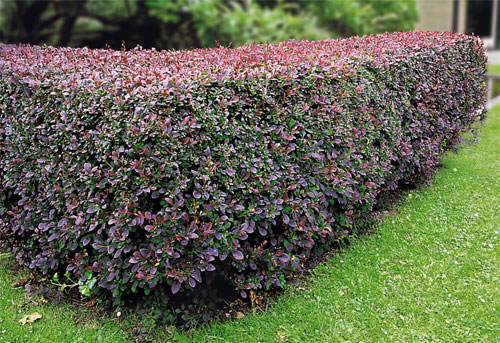
Closeup: Hedges
To create a hedge, you will need a lot of bushes, but this is natural, because it is broken down for many years. It is very important to think carefully about the choice of plants, place and time of planting.
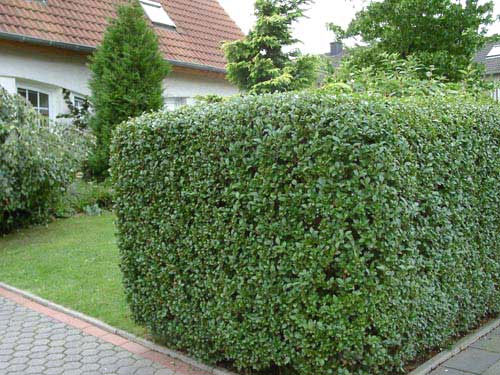
Not only hedges of roses and other flowers delight us with fragrance.
White privet flowers that bloom in June also fill the garden rich aroma and at the same time attract insects. Their sweet smell is a bit like the scent of linden flowers. Common privet (Ligustrum vulgare) is winter green and grows fast. The variety ‘Atroviens’ is especially good - in winter, the foliage is excellent on it.
Attention: oval-leaved privet (Ligustrum ovalifolium) sheds its leaves in winter. And the oval-leaved Privet cultivar 'Augenipg' with yellow-green leaves is also sensitive to frost.
In the foreground
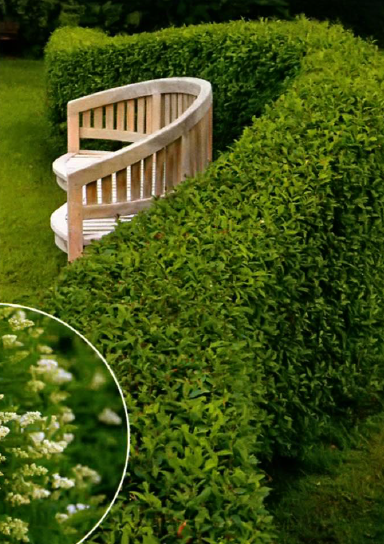
Often bare strips of earth at the roots of a hedge do not look very presentable. If you leave a little space to the adjacent path of slabs or stone, you can plant low-growing ground cover plants along the strip of shrubs.
Suitable landing time

1 In the shade of Photinia, the evergreen Morrow sedge (Carex morrowii) ‘Variegata’ feels especially good.
2 The partial shade sister violet (Viola sororia) ‘Albiflora’ gets along well with the hornbeam hedge, and (3) the flower sedum (Sedum floriferum) grows on the sunny side of the beech hedge.
Deciduous shrubs for hedges can be planted throughout the fall until the soil freezes. In addition, if you buy plants during the traditional planting period (spring - autumn), it makes sense to take advantage of great deals from garden centers and purchase seedlings with an open root system. They cost much less than plants in containers and are much more convenient to transport, as they are easy to transport bundled in several pieces.
When buying, be sure to check with the seller the potential size of the plant - the distance between the bushes and the total number of seedlings that will be required for your hedge depends on this.
Selection of plants for hedges - for every taste

1 Pyracantha bright red(Pyracantha coccinea): prickly evergreen shrub with bright red berries (autumn), suitable for medium to high hedges. Grows in full sun or partial shade.
2 Lavson's cypress(Chamaecyparis lawsoniana): tall evergreen conifer tree for sunny places protected from the wind.
3 Photinia Fraser(Photinia x fraseri) ‘Red Robin’: evergreen hedge shrub of medium height, suitable for regions with mild winters. In the spring it produces beautiful red shoots.
4 Barberry Thunberg(Berberis thunbergii) ‘Atropurpurea’: Sun-loving shrub with red leaves for medium height hedges.
5 Barberry Yulian(Berberis julianae): sun-loving evergreen shrub prickly leaves for hedges of medium height.
6 Honeysuckle brilliant(Lonicera nitida): low shrub for sun or partial shade, can replace boxwood.
7 Parthenocissus(Parthenocissus tricuspidata) can serve as a "hedge" by climbing a wall. Grows in full sun and partial shade.
8 Common hornbeam(Carpinus betulus): tall tree with foliage that changes color from green to yellow in autumn. In winter, the leaves turn brown and remain on the branches.
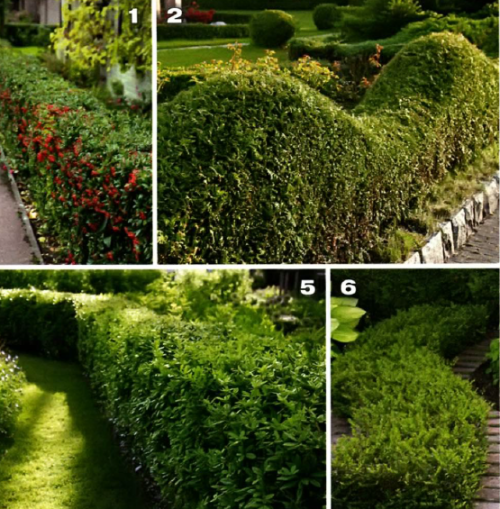
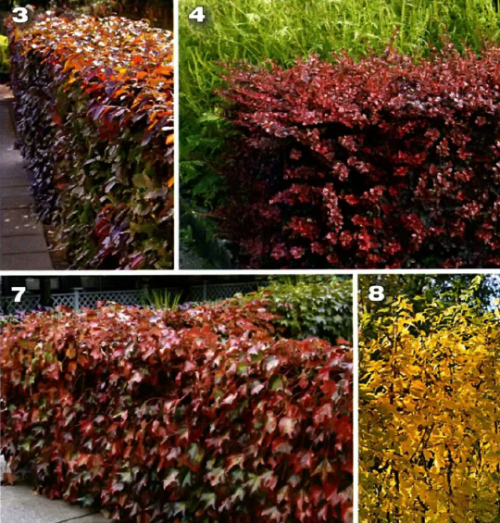
Such a different "hedge". Personal experience (video)
According to the magazine "My beautiful garden"
| Conifers in the country In garden centers and horticultural markets, you will not find any kind of conifers! Miniature Christmas trees, dwarf pines, all kinds of junipers, thuja balls and columns are a clear confirmation that decorative forms and varieties coniferous plants suitable for cultivation in middle lane our country... |
|
| Barberry Thunberg This popular ornamental shrub so easy to grow that even a beginner can easily get it in his garden. Barberry Thunberg will add bright colors to the composition! |
|
| We plant a hedge: planting technology April is the optimal spring time for planting hedges, this time is especially good for evergreens. It is best to purchase 3-5 year old coniferous seedlings in containers. However, during spring planting they take root well and ... |



